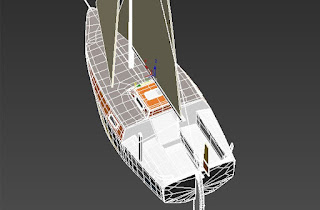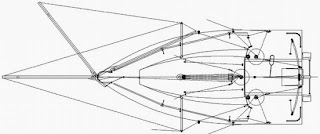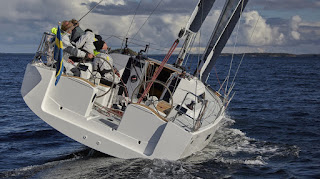Contrary to what is usual I am not posting about this boat because I find it interesting but because I find it impossibly dangerous for doing what the class mentor, the same that created the Golden Globe Race, has meant it for: a Globe Race disputed on this sailboat, to take place in 2024.
The profile design looks nice, kind of an old mini with a bigger freeboard, big protection over the entry hatch and an old wind pilot, the general aspect is solid, kind of look of a TT machine, a boat able to sail anywhere and the truth is that it had raised a huge interest and has been publicized on some of the main yacht magazines, including the biggest of them all, Yacht.de.
The boat is to be built at home by the "racers" using plywood, the plans are from the Polish yacht designer Janusz Maderski and cost only 300€. The complete boat would cost around 6000€ for a basic version, and 20 000€ for what is described as a fully equipped boat suited for bluewater racing.
Probably you are thinking that at least two mini-racers, that are only 0.8 m shorter in length, have already circumnavigated and that was not that dangerous because both had made it, although both had broken their masts in capsizing situations, having one of them the mast replaced and the other jury-rigged.
Except that a mini-racer stability has nothing to do with the one of this boat. Stability on a sailboat comes from hull form stability, which has to do with beam, with lowering the boat CG, that has to do with B/D, with draft and type of keel and comes from displacement.
It has also a great deal to do with displacement because RM is obtained multiplying displacement by the lever (GZ) that is obtained measuring at each point of heel the horizontal distance between the center of gravity (CG) and the center of buoyancy (CB). This video helps to understand how the lever (GZ) varies with heel and if you want to know more about this there are two links below, one to the site of the video, other to an inexpensive book that explains the basics of stability on a boat.
http://sailskills.co.uk/Stability/stability_site_map.html
https://books.google.pt/books?id=Rtg6T9kMZkUC&printsec=frontcover&hl=pt-PT#v=onepage&q&f=false
That is why generally a bigger and heavier sailboat has more overall stability than a much lighter sailboat and why some very heavy small sailboats can have better stability than what their size leaves to suppose, but of course, to sail well a sailboat needs to be light, more even if it is a race boat and therefore having a heavy sailboat is not a good idea in what regards sail performance.
That's why the small 6.50class mini, having to be light to be fast, maximize all the other ways to increase RM without adding weight, increasing the lever (GZ), namely through beam and through lowering the CG. That's why the 6.50 mini is so incredibly beamy.

The center of gravity is lowered on the 6.50 mini through a big B/D, an efficient lead torpedo keel and a big draft (2.0 meters on protos, 1,6 on Series). The lowering of the CG increases not only overall positive stability but even more AVS and safety stability but also reduces greatly negative stability, making the proportion between the two much bigger.
The Mini Protos needs less ballast for about the same needed RM (to pass the safety stability tests) due to a bigger 2.0 meter draft. The 1.60m draft of the Production boats makes them more adequate to compare its stability with the one of the 5.80 class, which has 20cm less draft, but a not very different keel with a lead torpedo.
Let's then compare a production Mini 6.50Class dimensions, for instance, a Pogo 3, with the ones of the new 5.80class:Regarding hull form stability the 5.80 is not only 0.8 m shorter (5.70 to 6.50) but has 0.7m!!! less beam. Regarding the keel, the Pogo has 0.2m more draft (1.40 to 1.60) and 245kg more ballast (220kg to 465kg, more than the double !!!) displacing the 5.80 only 220kg less than the Pogo (700kg to 920kg) for respectively a 31.4%B/D and a 50.1%B/D. And of course, that uncomparable superior B/D effect is maximized, regarding the one on the 5.80Class, due to a bigger draft.

 As you can see looking at the drawing of the new 5.80 class, it seems that the boat is just a slightly smaller, much less beamier, older designed 6.50class, but the stability of the two boats has nothing in common and while the mini is an offshore boat, to be sailed not in strong sea conditions, the 5.80class is a coastal boat and it is irresponsible to propose this as a boat for a circumnavigation race that passes in places and seas where the conditions are much stronger than on the low latitudes of the Atlantic on the calmest period.
As you can see looking at the drawing of the new 5.80 class, it seems that the boat is just a slightly smaller, much less beamier, older designed 6.50class, but the stability of the two boats has nothing in common and while the mini is an offshore boat, to be sailed not in strong sea conditions, the 5.80class is a coastal boat and it is irresponsible to propose this as a boat for a circumnavigation race that passes in places and seas where the conditions are much stronger than on the low latitudes of the Atlantic on the calmest period.
Comparing the two boats, the 6.50mini will have a much better overall stability, incomparably better safety stability, and a much higher AVS. The inverted stability would be much smaller and the considerably less windage and a much superior stiffness will contribute to a far better dynamic stability.
Reading the above one may think that a Class 6.50 Mini-Racer is an extraordinarily seaworthy boat for bluewater racing and crossing oceans, when it is really a boat on the limits of what is considered safe for doing that. The mini racers on a transat are accompanied by several support boats, 7 last year, that are there to provide a quick help if anything goes wrong and to relay VHF distress messages.
If you follow the mini transat you know that it is raced on the season when conditions are better to make an Atlantic crossing from France, that even so the departure date is frequently postponed for safety reasons due to bad weather (like last year), and that some times the race is just stopped, bringing all boats to safe ports to wait for conditions to improve, as it was the case in 2013.

There is also another difference: mini sailor racers to participate on the mini transat have to qualify themselves for it and have to do a 650Class 1000nm solo race or several ones totalizing 1500nm, having at least 500nm of those being made solo.
This assures that all the sailors doing the Transat have considerably minimum experience and know their boat very well.
Looking at the new 5.80 class and taking as an example what the requirements are to race a Transat on even smaller boats (by the same NA) we will see that it is enough to have 18 years and "the skippers are participating on their own risk". No previous solo racing experience on that boat (Setka 5.0) verified. It seems that race this year is going to be a success at least in what regards participation since there are already 10 entries.
http://www.maderski.pl/setk--przez-atlantyk-2020.html?fbclid=IwAR0h0IPgaimv3twVTX1N8DHe13F2ochia1oSkSgp9Bc_1KkD4xsaj3Y8lN4

It starts from Portugal, November 2020 and it seems to me that they don't have a clue on what the sea condition can be in November there.
The frequent bad weather in November between France and the Canary Islands is the reason why the Mini-Transat starts in September/October from France and the reason they wait some time on the Canary Islands before going South.
 It is to be sure they make the last leg on the best possible weather window, which is in November.This race on these boats is famous in Poland and it is already on its 3rd edition, in 2012 they were 5, only two finished but in 2016 all 8 boats finished on a Transat that experienced exceptionally good and fair winds.
It is to be sure they make the last leg on the best possible weather window, which is in November.This race on these boats is famous in Poland and it is already on its 3rd edition, in 2012 they were 5, only two finished but in 2016 all 8 boats finished on a Transat that experienced exceptionally good and fair winds.
You can see the conditions on the tracker below and I can tell you that rarely have I seen so good conditions and I follow several transatlantic races every year. Most of the time the max winds are of 30kt or more and on this particular year max winds stayed in the lower 20's. You can check that on the link below.
Of course, it is possible to cross the Atlantic in very small unsafe boats and get away with it most of the time but that does not mean an acceptable risk. For instance, on the ARC they only accept ClassA sailboats with 30ft minimum. Obviously, as the success of the 2016 edition showed, it is possible to do a Transat with much smaller boats and get away with it, most of the time. The question here is where you put the line in what regards seaworthiness and safety.
I salute the courage of those that want to race solo bluewater in manifestly unsafe sailing boats for ocean racing, but sailing competitions in crafts that do not offer minimum safety requirements should not be allowed and that is why World Sailing demands specific stability requirements and safety equipment on boats for participating in Ocean Races that draw that line at what they consider an acceptable safety and minimum risk.

Note that I don't have anything against somebody risking his life the way he wants, sailing or otherwise, but that should not have anything to do with sport. There are many sports that involve risk and Ocean Solo Sail Racing is one of them, but the risk has to be a controlled one and all the measures needed to diminish that risk should be and are taken.
Sailing as a sport should be regulated within acceptable risks without creating significant conditions to put sportsmen and other people's lives in jeopardy, namely, the ones that will have to rescue some of those who participate in excessively dangerous races, races where rescues will not be a small possibility but a big possibility.
Not to mention the cost of those operations and the increased risk that someday those costs will be passed to all of us through the need for compulsory rescue insurance for offshore sailing.
If you want a small reasonably seaworthy sailboat for offshore sailing instead of building one of these buy a second-hand old mini. There are many not competitive anymore that can be bought for the same that would cost to build a 5.80class sailboat or if you want to build yourself a boat there are plans to build one like these on the link below by Dudley Dix (above on the photo):
https://dixdesign.com/didiminiMk3.htmhttps://mini650projectdubai.wixsite.com/mini650projectdubai/blog/page/3
And if you want a more competitive 650class racer in plywood/epoxy, there is this option:
https://www.voileetmoteur.com/voiliers/actualite-voile/un-mini-6-50-biosource-pour-les-constructeurs-amateurs/89636











































